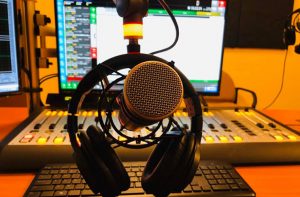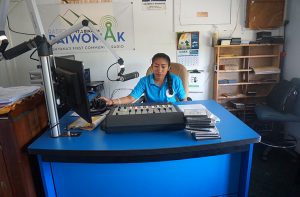How regional radios are driving community awareness on Coronavirus
By Ravena Gildharie
IT IS 17:00 hrs and a Wapishan farmer in Deep South Rupununi has just retired from his farm; his attention is now directed to his portable radio on which he awaits community updates and information broadcasted live via Radio Aishalton and in his native Wapishan language. During this Coronavirus pandemic, awareness is crucial and for rural and hinterland communities where access is limited to even the traditional television, and more so information and communication technology (ICT), broadcast radio remains the premier communication channel.
With restrictions on transportation, movement of people, public activities and gatherings, community, regional and other authorities are relying heavily on these regional radio stations to drive awareness, and to keep the far-flung rural and indigenous populations informed of the situation with regards to the novel Coronavirus – COVID 19. To ensure broader sensitisation of their audiences, the regional radios, particularly those in the Rupununi, are broadcasting the health advisories and Coronavirus information in the local indigenous languages. These include Makushi, Patamona and Wapishan.

Currently, there are regional radio stations at Aishalton, Lethem, Annai, Mahdia, Orealla, Bartica and Mabaruma. Most of the airtime syncs with the national radio transmission, but each regional station has its own schedule of local programmes ranging from airtime of two to four hours per day or several times per week. Radio Paiwomak at Annai is the only community radio that broadcasts daily local content for most of its time on air.
Regional Radio/Production Manager of the National Communications Network (NCN) Michella Abraham-Ali explained to Pepperpot how each station submits a weekly report that is compiled into “Focus on the hinterland,” a programme broadcast nationally on Voice of Guyana (VOG).
“This is an excellent way of the regions feeding into the national broadcast,” Abraham-Ali indicated, adding: “It’s a two-way street. VOG relaying to them and the regional stations sending us content. We also do link ups when interviews are being done with regional officials or they are recorded and we air on VOG.”
Radio Paiwomak, the oldest community-based radio station in Guyana, which transmits to communities of the North Rupununi, usually tunes in to VOG for the national news broadcast, BBC and other important messages and statements.
Broadcasting in native language
Since the Coronavirus though, some of the newer regional radios have increased their hours of local programme including Radio Aishalton, which now transmits daily between 17:00 hrs to 18:00 hrs from Monday to Saturday.
Leah Casimero is one of three local broadcasters stationed at Radio Aishalton. A local Wapishan resident, she has been attached there since the station was launched a little over a year ago.

“Since we’ve had the ban on public meetings and gatherings, the Toshaos have been telling residents to follow the radio for messages, information and updates on what is happening in the community and elsewhere with the Coronavirus,” she informed the Pepperpot Magazine. The community leaders, as well as regional officials supply the radio station with information in English, and the Aishalton broadcasters have been translating these into Wapishan.
“We have also been tailoring some of the information,” Casimero added, noting: “…for instance there are messages that advise the use of Lysol and hand sanitisers…or tells us how to wash your hands in the sinks and to use paper towels…Here in the South Rupununi, we don’t have things like that…we don’t have sinks, we have buckets and basins. So we have been tailoring the information to suit local conditions…so our people better understand what precautions to take.”
Radio Aishalton has been airing too recorded presentations of local health officials who recently conducted a Coronavirus sensitisation session with South Rupununi communities.
Trusted and timely information
According to Casimero, the broadcasts reach about fifteen communities of the Deep South Rupununi, where residents depend on the radio for authentic and timely information. She described scenarios where farmers take their radios with them in the fields and; where they make the purchase of batteries for their radios a priority. The young woman acknowledged that there are communities with mobile phone signals, while others have Wi-Fi. However, these services are very limited, and the radio remain the only dependable source of communication in the far-flung district.
Similarly, in the North Rupununi, Radio Paiwomak is molded in the fabric of the communities’ development linked to vibrant activism and governance of the North Rupununi District Development Board (NRDDB), a representative umbrella body. Michael Williams, a NRRDB board member, has been broadcasting on Radio Paiwomak for about fifteen years. These days, he is one of several local broadcasters who share Coronavirus updates and Public Service Announcements at 15-20-minute intervals. These are broadcast in English, Makushi, Wapishan and Patamona, and according to Williams, some residents have begun feeling inundated by the Coronavirus messages. Nevertheless, he said the importance of the messages remains intact, and Radio Paiwomak continues to play a major role in spreading awareness on the pandemic.
At Lethem, Allison Camacho is on Radio Lethem updating listeners daily about Coronavirus including sharing voice notes from doctors of the Lethem hospital, who offer advice on sanitation and precautions for residents to follow. Radio Lethem has become the primary outlet for the Region Nine Administration to report on the work of its taskforce that is monitoring the risk at the border town. The situation intensified after a resident in the neighbouring Bom Fim, Brazil, tested positive for the virus. Aside from conducting its own broadcast, Radio Lethem is responsible for disseminating to the other regional radios, the updates and advisories emanating from the border town.
Knowledge-sharing on radio
Meanwhile, Radio Mahdia is facilitating weekly Coronavirus updates led by the Regional Health Officer, according to broadcaster Lesa Lee.

“We have been having the RHO herself on radio for our local programme, talking about the novel Coronavirus and the Region’s preparations should a case arise. Also on all of our programmes, we play ads and remind persons of the necessary precautions and measures they should implement,” Lee said. Listeners are encouraged to contact the Mahdia hospital for information or to make requests for what updates they want to be shared publicly on Radio Mahdia.
The radio station reaches communities of Mahdia, Campbelltown. Micobie, El Paso, Muruwa and other surrounding mining areas. Lee is certain that the regional radio is playing a major role in sensitising people about Coronavirus as she related how residents and listeners have been contacting the local broadcaster and expressing their gratitude for the updates and awareness on the pandemic.
Across the country, in the North West District, Radio Mabaruma has also been spearheading its own initiatives to deliver current information on the global outbreak. Local broadcasters have conducted and recorded interview with the Regional Health Officer there and is broadcasting same during the local programme. The radio station has been transmitting advisories to residents on what measures are being taken in the region and countrywide in response to the COVID – 19. For instance, the radio has been used to inform residents of the schedule and restrictions for travel aboard the MV Kimbia traversing the Georgetown-Mabaruma route. Via radio, the residents are alerted of passengers’ screening upon arrival and restrictions against crowding particularly at the ‘landing’ where goods and passengers are offloaded.



.jpg)











